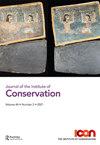Editorial
IF 1
0 HUMANITIES, MULTIDISCIPLINARY
引用次数: 0
Abstract
The final issue of the 2022 volume of the journal begins with three articles that in their own ways address the perennial question of what kinds of skills educators should emphasise in their curricula for teaching conservation. Robyn Sloggett’s article, ‘Conservation skills’, takes the bull by the horns to wrangle out the differences between what educational institutions can and do provide and what employers and other agencies involved in conservation might be expected to contribute towards. Against the notion that graduates somehow lack core competencies in ‘treatment skills’—as has variously been suggested in recent years—Sloggett argues that contemporary conservation skills have been reconfigured by a technical, social and intellectual pluralism, and embedding this in the curriculum is the real challenge for conservation education to advance in the twenty-first century. Sloggett’s argument is followed by Salvador Muñoz Viñas’, ‘Conservation science, conservation practice and the conservator’s knowledge: a naïve exploration’, in which he suggests that in making decisions about treatments conservators draw on a reservoir of tacit knowledge which can only be developed in the workplace rather than in an educational setting. He argues that even where conservation is made more ‘factual’ through science such an approach is always redundant in the decisionmaking that conservators typically execute when caring for something. To illustrate this he presents a case study and navigates 42 treatmentrelated questions to demonstrate how science proves insufficient in answering any of them. He concludes that it is the tacit build up of experience, primed in training but developed in the workplace, that allows the conservator to answer such questions and concomitantly moves the individual along the novice-to-expert axis. That skills and know-how are best developed in the workplace is further corroborated by Grace Barrand and Marcelle Scott’s contribution, ‘Targeting specialist skills through Work-Integrated Learning: a case study in frames conservation at the Art Gallery of New South Wales’. Progression along the novice-to-expert axis is played out across Barrand’s structured mentorship at AGNSW where her skills were actively developed in a series of tasks designed by staff in the frames conservation department. Using a Work-Integrated Learning approach over 12 months they targeted developing Barrand’s cognitive skills such as muscle memory and pattern recognition to consolidate and improve her professional competencies. The positive results suggest support for Sloggett’s argument for more structured input from industry and offer an industry relevant training model for others to adapt to address any gaps they see in the skillset of their new employees. The fourth article, Cancy Chu, Sarah Bunn, Melanie Barrett and Petronella Nel’s ‘Investigating the efficacy of interleaving materials in the preservation of plasticised PVC slip-cover notebooks in Yang Zhichao’s artwork Chinese Bible’ looks at some of the science behind the problem of plasticised poly(vinyl chloride) (PVC-P) degradation. From a case study of the Chinese artist Yang Zhichao’s 2009 artwork, Chinese Bible, which includes hundreds of PVC-P covered notebooks, three materials— Mylar®, Hollytex® and buffered tissue—were interleaved within the notebooks and the whole stack artificially aged to model their storage conJournal of the Institute of Conservation, 2022 Vol. 45, No. 3, 155–156, https://doi.org/10.1080/19455224.2022.2130548编辑
该杂志2022卷的最后一期以三篇文章开头,这些文章以自己的方式解决了一个长期存在的问题,即教育工作者应该在课程中强调什么样的技能来教授保护。罗宾·斯洛格特(Robyn Sloggett)的文章《保护技能》(Conservation skills)勇敢地争论了教育机构能够提供和确实提供的内容与雇主和其他参与保护的机构可能做出的贡献之间的差异。Sloggett反对毕业生在某种程度上缺乏“治疗技能”的核心能力的观点——正如近年来各种各样的说法所表明的那样——他认为,当代的保护技能已经被技术、社会和智力的多元化所重新配置,将其嵌入课程中是21世纪保护教育发展的真正挑战。Sloggett的论点之后是Salvador Muñoz Viñas的“保护科学、保护实践和保护人的知识:一种天真的探索”,他在其中建议,在做出治疗决定时,保护人利用了隐性知识库,这些知识只能在工作场所而不是教育环境中发展。他认为,即使在通过科学使保护更加“真实”的情况下,在保护人员通常在照顾某物时执行的决策中,这种方法也总是多余的。为了说明这一点,他提出了一个案例研究,并浏览了42个与治疗相关的问题,以证明科学是如何证明不足以回答其中任何一个问题的。他得出的结论是,正是经验的隐性积累,在训练中得到了准备,但在工作场所得到了发展,才让保育员能够回答这些问题,并使个人沿着新手到专家的轴线前进。Grace Barrand和Marcele Scott的贡献“通过工作综合学习瞄准专业技能:新南威尔士美术馆框架保护案例研究”进一步证实了这种技能和专业知识在工作场所得到了最好的发展。Barrand在AGNSW的结构化指导下,沿着新手到专家的轴线不断进步,在框架保护部门的工作人员设计的一系列任务中,她的技能得到了积极发展。他们在12个月的时间里采用了工作综合学习的方法,旨在培养Barrand的认知技能,如肌肉记忆和模式识别,以巩固和提高她的专业能力。积极的结果表明,Sloggett的论点得到了支持,即来自行业的更结构化的投入,并为其他人提供了一个与行业相关的培训模式,以适应他们在新员工技能方面看到的任何差距。第四篇文章,Cancy Chu,Sarah Bunn,Melanie Barrett和Petronella Nel的“研究杨志超的艺术作品《中国圣经》中交织材料在塑化聚氯乙烯封面笔记本保存中的功效”,探讨了塑化聚氯乙烯(PVC-P)降解问题背后的一些科学。根据中国艺术家杨志超2009年的作品《中国圣经》的案例研究,其中包括数百本PVC-P覆盖的笔记本,三种材料——Mylar®、Hollytex®和缓冲组织——被交错在笔记本内,整个堆叠被人工老化以模拟其存储,https://doi.org/10.1080/19455224.2022.2130548
本文章由计算机程序翻译,如有差异,请以英文原文为准。
求助全文
约1分钟内获得全文
求助全文
来源期刊

Journal of the Institute of Conservation
HUMANITIES, MULTIDISCIPLINARY-
CiteScore
1.50
自引率
0.00%
发文量
22
期刊介绍:
The Journal of the Institute of Conservation is the peer reviewed publication of the Institute of Conservation (Icon). As such, its aims reflect those of Icon, to advance knowledge and education in conservation and achieve the long term preservation and conservation of moveable and immoveable cultural heritage. The Journal provides a collective identity for conservators; it promotes and supports both the profession and professionalism. With international contributions on all aspects of conservation, it is an invaluable resource for the heritage sector. The specific aims of the Journal are to: 1. promote research, knowledge and understanding of cultural heritage conservation through its history, practice and theory 2. provide an international forum to enable and disseminate advances in research, knowledge and understanding relating to conservation and heritage 3. champion and support professional standards of heritage conservation in the UK and internationally 4. provide a permanent record of issues relating to conservation and heritage 5. be financially and operationally sustainable. To achieve these aims, the Journal invites contributions from all those involved in the conservation of cultural heritage and related activities. Areas of interest include understanding cultural heritage materials and their degradation; subject reviews and histories of cultural heritage materials and conservation treatments; new, innovative or improved approaches to conservation and collections care theory, practice, communication, management and training; case studies demonstrating new, innovative or improved approaches; and conservation in its wider context. Submitters are encouraged to demonstrate how their work is of practical application to conservation. To maintain professional standards and promote academic rigour, submissions of articles and shorter notices are subject to an anonymous peer review process.
 求助内容:
求助内容: 应助结果提醒方式:
应助结果提醒方式:


